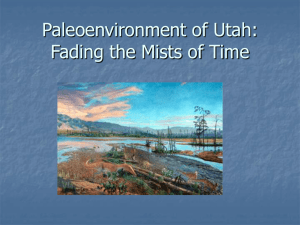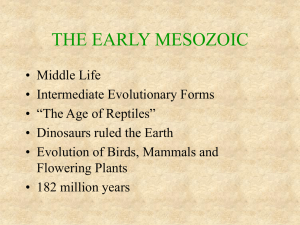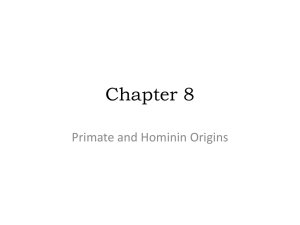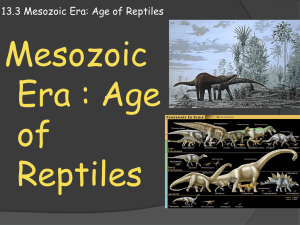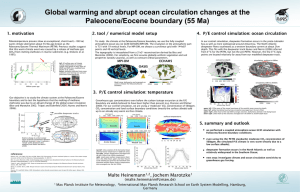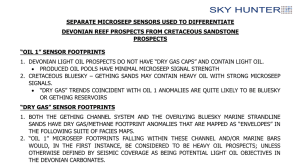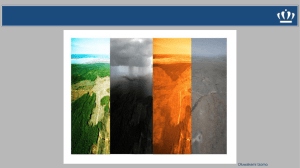Gulf Trough/Suwannee Strait - Georgia Southwestern State University
advertisement
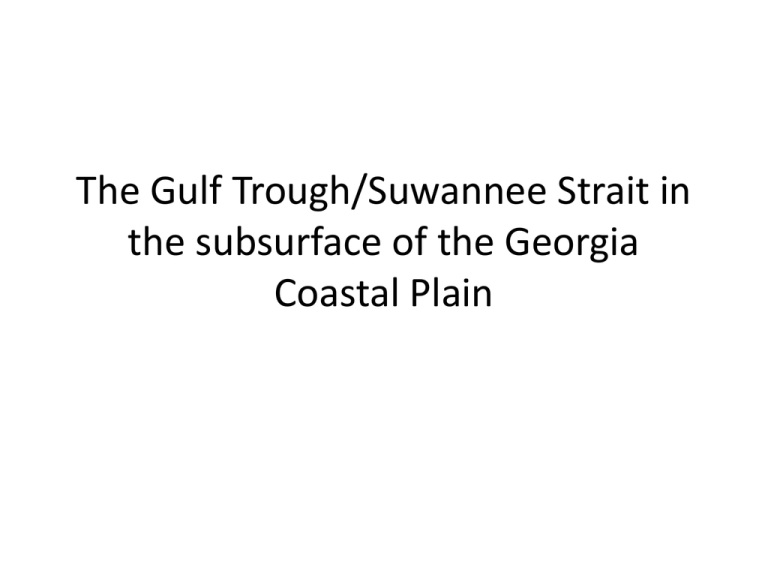
The Gulf Trough/Suwannee Strait in
the subsurface of the Georgia
Coastal Plain
“Trough” is a term that a geologist interested in
sedimentary rocks would use.
A “trough” in this sense is an elongate basin that could be or has
been filled with sediment.
The shape of that body of sediment (or sedimentary rock, after it
became lithified) would be very distinctive.
The Tongue of the Ocean
is a deep-water feature
that dissects the Great
Bahama Bank east of
Andros Island.
Because of its shape it is
potentially a sedimentary
trough.
If you imagine filling it
with sediment, that body
of sediment would have a
distinctive overall shape –
not one like a delta
(wedge) or a lake (lens)
or a desert dunefield
(sheet).
The shape of sediment fill in a trough is comparatively long in one horizontal
dimension. Fill in the Tongue of the Ocean would be elongate in a NNW/SSE
direction.
In both the other horizontal dimension, at a right angle to the long one, and in
terms of sediment thickness (the vertical dimension) the sediment body would be
shorter and thinner. Fill in the Tongue of the Ocean would be narrow in a
ENE/WSW direction and roughly as thick as it would be wide.
In cross-section (along the short line on the map)
it would look something like the diagram below.
Sediment
Fill
short dimension
long dimension
Stratigraphers therefore have two ways to recognize an ancient trough, like the Gulf
Trough. We can recognize the basin itself or recognize the distinctive shape of the
basin fill.
To show you how we “see” and illustrate these things, first I need to take you on a
short side trip.
First, consider the
symbolism of the
Contour lines on a
topographic map.
Each contour connects
Points of equal
elevation, enclosing
higher elevations and
excluding lower ones.
Closer spacing =
Steeper ground.
Highest point on a hill
Is in the center of the
center contour line.
Holocene
Second, remember that the
rocks deposited to form the
Coastal Plain range in age from
Triassic to Holocene.
YOUNGER
Pleistocene
Pliocene
Miocene
Oligocene
The Gulf Trough has persisted for
much of that time, eventually
filling entirely some time after
the Oligocene.
Eocene
Paleocene
U. Cretaceous
Time units are usually
represented in a vertical column,
oldest at bottom, because that is
the way we expect them to stack
as they accumulate
L. Cretaceous
Jurassic
Triassic
OLDER
“basement”
Geologists use the same contour line symbolism for other values than modern land
surface elevation. The map below uses them to illustrate the elevation of the top
of a particular rock body (whatever is below the lowest Cretaceous rock) buried
under the Coastal Plain. Negative values indicate a depth below sea level.
The values for this
map come from
measured depths to
this surface in deep
water and oil test
wells.
Holocene
Pleistocene
Pliocene
Miocene
Oligocene
Eocene
This sort of map is
called a “structure
contour map”.
Paleocene
U. Cretaceous
L. Cretaceous
Jurassic
The surface has a
pronounced trough in
deep southwest GA,
with its greatest depth
right at the southwest
corner of the state.
Triassic
“basement”
(from Herrick and Vorhis, 1963)
Holocene
Pleistocene
Pliocene
Miocene
Oligocene
Eocene
Though the axis of the trough shifted as it filled, the two
structure contour maps below show that it persisted through
the end of the Eocene (left -- ~34my) and the end of the
Oligocene (right -- ~23my).
Paleocene
U. Cretaceous
L. Cretaceous
Jurassic
Triassic
This persistence probably resulted from both the time required
to fill such a deep hole and continued subsidence of the trough
as it filled.
“basement”
(both from Herrick and Vorhis, 1963)
Geologists use the same symbolism for other values than elevations. The map below
uses contour lines to illustrate the total thickness of a particular rock body (the Lower
Cretaceous package) buried under the Coastal Plain.
The values for this
map come from
measured thickness
in deep water and
oil test wells.
Holocene
Pleistocene
Pliocene
Miocene
This sort of map is
called an “isopach
map”.
Oligocene
Eocene
Paleocene
U. Cretaceous
The rock body has
partially filled the
trough on the
pre-Cretaceous
surface shown in a
previous slide.
L. Cretaceous
Jurassic
Triassic
“basement”
(from Herrick and Vorhis, 1963)
In the Late Cretaceous, and probably in the Paleocene, the isopach maps and other
evidence points toward a different orientation for the trough. The map below at
right summarizes the various thickness patterns seen in the Coastal Plain rocks.
Holocene
Pleistocene
Pliocene
Miocene
Oligocene
Eocene
Paleocene
U. Cretaceous
L. Cretaceous
Jurassic
Triassic
“basement”
(from Herrick and Vorhis, 1963)
Holocene
Pleistocene
Pliocene
Miocene
Oligocene
(from Herrick and Vorhis, 1963)
Eocene
Paleocene
U. Cretaceous
L. Cretaceous
Jurassic
Triassic
“basement”
Isopach map
{
Structure contour map
Holocene
Pleistocene
Pliocene
Miocene
Oligocene
Eocene
Paleocene
Miocene to Recent fill
of …
U. Cretaceous
L. Cretaceous
Jurassic
Triassic
… an end-Oligocene
trough.
(from Herrick and Vorhis, 1963)
“basement”
That is the evidence for a
Gulf Trough.
What is the “Suwannee
Strait”?
“Strait” is a term a geographer would use to identify
a narrow body of water connecting two larger bodies
of water. Usually when I think about this thing I
think about it as a paleogeographer.
Straits are also frequently fairly deep as well as being narrow.
They frequently allow a current to flow from one large water body to the other.
The deeper water in the strait, the scouring potential of any current that is
present, and the differences in current, wave, and tide conditions farther away
from the strait often mean that sediment types occur in bands parallel to the
strait edge.
Those sediment types recur along straits of different ages.
The Florida Straits connect the Gulf of Mexico to the Atlantic. The northern branch of the
Florida Straits carry the main body of the Gulf Stream out of the Gulf and into the Atlantic.
Gulf Stream
FLORIDA
STRAITS
Florida Bay – Lime Mud
Holocene
Pleistocene
Pliocene
Miocene
Lower Keys
Oligocene
Eocene
Marathon
Paleocene
U. Cretaceous
L. Cretaceous
Jurassic
Triassic
“basement”
?
Key
West
?
Reef
Tract
?
?
Two common members of the
red algal community that lives in
the rhodolith gravel below the
reef tract in southern Florida.
Red algal rhodolith from Florida (Recent)
Meoma ventricosa from White Banks, Florida (Recent)
Distribution of the Bridgeboro
Limestone, a rhodolith-rich
Oligocene rock.
Holocene
Pleistocene
Pliocene
Miocene
Oligocene
Eocene
Paleocene
U. Cretaceous
L. Cretaceous
Jurassic
Triassic
“basement”
(Huddlestun, 1993)
(Manker and Carter, 1987)
A cross-section of the
Oligocene and younger
strata in the Gulf Trough
in southwestern
Georgia.
(Huddlestun, 1993)
Holocene
Pleistocene
Pliocene
Miocene
Oligocene
Eocene
Paleocene
U. Cretaceous
L. Cretaceous
Jurassic
Triassic
“basement”
Two common members of the
red algal paleocommunity that
occurs in the Bridgeboro
Limestone (Oligocene) flanking
the Suwannee Strait in
southwestern Georgia.
Holocene
Pleistocene
Pliocene
Miocene
Oligocene
Eocene
Paleocene
U. Cretaceous
L. Cretaceous
Jurassic
Triassic
“basement”
Archaeolithothamnium sp.
(one cut to show characteristic internal structure)
Macropneustes mortoni
Recent (Florida)
Holocene
Pleistocene
Pliocene
Miocene
Oligocene
Eocene
Paleocene
U. Cretaceous
L. Cretaceous
Jurassic
Triassic
“basement”
Oligocene (Georgia and Florida
A Paleocene rhodolith from the algal member of the Clayton Limestone
Holocene
Pleistocene
Pliocene
Miocene
Oligocene
Eocene
Paleocene
U. Cretaceous
L. Cretaceous
Jurassic
Triassic
“basement”
Holocene
Pleistocene
Pliocene
Miocene
Oligocene
Also occur
~120km
almost due
west at
Rutledge, AL
Eocene
Paleocene
U. Cretaceous
L. Cretaceous
Jurassic
Triassic
“basement”
The first indication of the existence of a Suwannee Strait came
from the work of two paleontologists (Ester and Paul Applin)
interested in Foraminifera – tiny protozoans with an excellent
fossil record. Their size insures that they can be taken whole
from well samples, and so they are very well studied by
petroleum geologists.
The bulk of the Applins’ evidence for a strait was the disjoint
occurrence of sediment types and the apparent distinction of
the types of forams on either side of the strait.
Straits are often sites of biotic disjunction – boundaries
between two biotic provinces – because they block migration.
One of the key
observations that led
A.R. Wallace to his
evolutionary ideas
was the “Wallace
Line”.
Holocene
Pleistocene
Pliocene
Miocene
Oligocene
Eocene
Paleocene
U. Cretaceous
At approximately the
Sunda Strait in
Indonesia the typical
Asian biota ends and
the Australian biota
replaces it.
L. Cretaceous
Jurassic
Triassic
“basement”
Of course Wallace was studying land animals and
plants, and it makes sense that a strait should hinder
their movements.
Forams are marine, so why a seawater barrier should
stop them is not very obvious.
Still, many types of marine fossil organisms seem to be
different on either side of the Suwannee Strait.
In the early 90’s I wanted to know why.
Holocene
Pleistocene
Pliocene
Miocene
Oligocene
Eocene
Paleocene
U. Cretaceous
L. Cretaceous
Jurassic
Triassic
“basement”
Clustering locations
based on the sea urchin
species of middle
Priabonian age that
occur at them, most of
the peninsular Florida
samples group together
(except Ocala). These
are coded blue on the
diagram. Ocala is in
green to show its
different cluster
membership.
All of the Georgia
samples occur in three
somewhat different
groups. These are coded
in pink.
Holocene
Pleistocene
Pliocene
Miocene
Oligocene
Eocene
Paleocene
U. Cretaceous
L. Cretaceous
Jurassic
Triassic
3 of the Georgia groups
actually link more closely to
the primary Florida group
(black circles) than to the
primary Georgia group (black
squares).
“basement”
More similar to each
other than any is to
main Georgia cluster.
4 clusters link at
this node.
Holocene
Pleistocene
Pliocene
Miocene
Oligocene
Eocene
Paleocene
U. Cretaceous
L. Cretaceous
Jurassic
Triassic
“basement”
The real reason for the difference
in organisms are the types of
sediment for them to live in!
We concluded that the Suwannee Strait was not
an effective barrier to marine migrations.
In rocks of each small slice of time we examined
either the fossils were the same, the sediment
types didn’t match, or one side of the Strait had
too few fossils to compare effectively.
Where did the Suwannee
Strait come from?
Origins of the Suwannee Strait
x x
Triassic volcanoes?
Holocene
Pleistocene
Pliocene
Miocene
Oligocene
Eocene
Paleocene
U. Cretaceous
L. Cretaceous
Jurassic
Triassic
“basement”
Arden, 1974
Long, 1974
Holocene
Pleistocene
East
African
Rift Basin
(eastern
arm)
Pliocene
Mt.
Kenya
Miocene
Oligocene
Eocene
Paleocene
U. Cretaceous
L. Cretaceous
Jurassic
Triassic
“basement”
Mt.
Kilimanjaro
Indian
Ocean
Holocene
Pleistocene
Pliocene
Miocene
Oligocene
Eocene
Paleocene
U. Cretaceous
L. Cretaceous
Jurassic
Triassic
“basement”
Chowns and Williams, 1983
There are numerous rift
basins along the
eastern side of North
America. They were
active as this continent
first tried to rift from
Pangaea, but finally
failed as the rifting
shifted to what is now
the Mid-Atlantic ridge.
Exposed
Buried
Cuba
Florida Straits
Holocene
Disneyland
Suwannee Strait
Pleistocene
Reef Tract
Pliocene
Miocene
Reef Tract
(~Pelham Esc.)
Oligocene
Eocene
Paleocene
U. Cretaceous
L. Cretaceous
Jurassic
Triassic
White Banks
“basement”
Dougherty Plain
